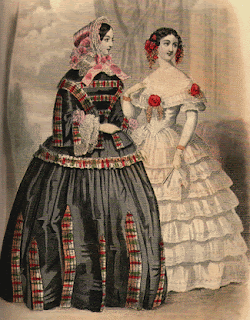The romantic age that claimed of freedom and individualism and maybe considered to have given voice to feminism, popularized fashion trends that were contrary to these movements.
These sleeves were accompanied by high waistlines and low, expanded necklines in order to give proportion to the body but the expansion, I believe caused women to look broad-shouldered and rather manly so it was soon ruled out. However, the high waistline that made the waist appear very small and fragile was supported with stays on the inside. These stays are what maybe considered contradicting the Romantic ideology since they majorly consisted of corsets which attacked women’s freedom to breathe!
The Imbecile sleeve
The romantics were fascinated by beauty- whether it was in nature, music, art or poetry. They valued emotion and sentiment, in contrast to the cold reason that was perceived to have driven the revolutions of the 18th century enlightenment. Since women were believed to be more emotional than men, it perhaps explains why the Romantics enjoyed such fashion trends. This style of dressing was designed to accentuate the beauty of the females by presenting them as frail maidens, which rather pushed them back into a more modest role, befitting the "weaker" sex, often described as delicate, fragile, and decorative. Women were also placed on a moral pedestal, and looked upon as the guardians of family and community virtue, and the educators of the children. This moral elevation of women would lead some to suggest that women deserved a wider role in public affairs. However, dress reflected the perception of women as weak and decorative, which smudges the comparatively exalted position women enjoyed in the romantic society.
 |
| The Crinoline cage |
The Victorian era brought with it crinolines and bustles, initially liberating the ladies from corsets and frills. The crinoline cage, which substituted the numerous layers of frilly petticoats and ‘frou-frou’ used to puff up the skirts, was supposed to be a breakthrough in the history of fashion. It was a cage made either of steel or whalebone worn beneath the skirts to make them ideally puffed. It allowed the women to abandon corsets as the huge crinoline made the waste look unbelievably small anyway. However, it became quite difficult to manage while sitting and immensely humiliating when the wind blew because the ladies did not only have to sober the skirts but also save themselves from being tossed to a side under the pressurizing weight! Not just that, owing to the crinoline their lives were made even more miserable by living in constant fear of falling off horses! Almost a decade later crinolines were abandoned and corsets crept in again to accompany the ‘bustle’. It was a modification of the crinoline puffing up only the sides and back and was later enhanced by adding springs to make seating more comfortable!
The Bustles

However, it is sad that women in my era have become too engrossed in everything other than their true nature to have forgotten about it. So, dear women of the world, do what you please, find your spot, but don't lose yourself on the way. Grace and intellect is a part of you, find it and treasure it.




No comments:
Post a Comment